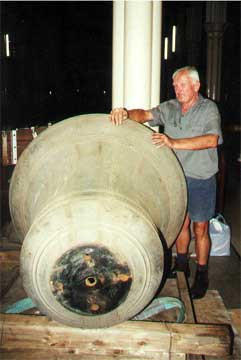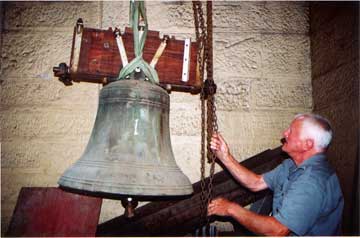Bells
St Benedict’s Church, Broadway was the first Catholic parish church in Australia to have change-ringing bells and now has the four oldest (cast in 1849) bells on mainland Australia which are still hanging in their original tower. The bells were first rung on New Year’s Day in 1851 and were believed to be rung by the Benedictine monks to notify St Mary’s Basilica when Archbishop Polding passed by on his return from Parramatta. St Benedict’s is also one of only three Catholic parish churches in Australia with change-ringing bells. At present the bells are rung on most Sunday mornings, for special saints’ feast days, other major church celebrations, weddings, funerals, and on civic occasions such as New Year’s Eve and Anzac Day.
Details of the bells
- Six bells originally cast in 1849 by C. & G. Mears of Whitechapel Road, London.
- Bells hung in St Benedict’s tower and first rung on New Year’s Day 1851. The bells were and are still rigged for the English style of full circle ringing.
- Replacements for the two tenor bells were cast in 1922 by Mears & Stainbank. The reason that replacements were needed is not reliably recorded. Anecdotal records suggest that at least one of these bells was cracked by the ill reputed practice of chiming the bells by “clocking”.

David Hobbs and the tenor bell during the removal of the bells from the tower and church prior to transport to England for refurbishment and tuning in 2000. The tenor weighs some 0.75 tonne and had to be placed on its side to allow it to pass through the doorway at the base of the tower. The bell is actually squatter (shorter) than it is wide—so by tipping it on its side the crew was able to get it in and out of the doorway. Old style bells (the tenor and No. 5 bells were replaced by new bells in 1922 but the replacements were cast to match the original 1849 bells—but without the cannons on top and without cast in stirrups to support the clappers) were proportioned with wide mouths. Bells cast in the later 1800s have comparatively narrow mouths.
- In about 1975 a Sydney bellringer, George Williamson, carried out refurbishment work on the bells which included replacement of the original timber headstocks on the remaining four 1849 bells with laminated timber headstocks and ball bearings.
- Despite the 1975 refurbishment work the bells were difficult to ring due to the poor rope circle (the treble ringer needed to stand on a plank in the doorway with his/her head cranked beneath the door head), the long rope draft on the treble bells and the inaudibility of the trebles which were located on the top level of a three storey frame. Furthermore the loose joints in the timber frame resulted in movement of the frame and the bells’ fittings (especially the wheels, clappers and pullies) had either deteriorated or worn excessively.

This picture of David Hobbs and the treble bell shows the laminated timber headstock as installed on bell Nos 1 to 4 by George Williamson in the mid 1970s. The treble weighs about 0.3 tonne.
- In 2001 the bells were removed and shipped to England for restoration by Eayre and Smith of Melbourne (bell engineers) and tuning by the Whitechapel Bell Foundry. A new steel frame weighing 3.25 tonnes was fabricated and erected by volunteer labour and the refurbished bells complete with all new fittings (wheels, pullies, clappers, stays and sliders) rehung. The steel frame is more efficient of space and allows the bells to be hung on two levels. The four 1849 bells are the oldest change-ringing bells in mainland Australia still extant in their original tower and still retain their cannons.
Become a bell-ringer at St Benedict’s.
Bibliography
Cummins, John J. (2006). “St Benedict’s, Broadway: 1850–2005” in The ringing years: a history of Sydney’s Catholic towers, pp. 233–49. Goonellabah, NSW: Dragonwick Publishing.